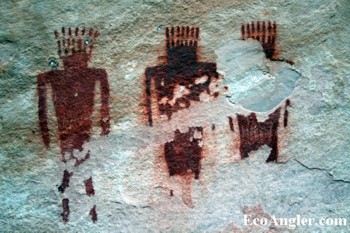Fly Fishing Jones Hole Creek in Dinosaur National Monument
Jones Hole Creek empties into the Green River through a narrow canyon inside Dinosaur National Monument; it's blanks are lined with cottonwoods, box elders, various grasses and nettles which provide excellent cover for the trout, but can make casting flies a challenge.
Major Powell named the creek here Bishop Creek after his chief topographer on the 1871 expedition. Jones Hole was initially credited to Stephen Vandiver Jones, the assistant topographer on the trip. But it seems not to have been called "Jones Hole" by the locals until after a tragic incident in 1883. In an attempt to get back his wife and children who had left him, Charley Jones knifed his wife's new love interest. Thinking he murdered the man, Jones holed up for the winter in this remote canyon.
As for the fishing, it's reported that one of Powell's men caught 20 trout here. Nathaniel Galloway of the Galloway-Stone expedition, in 1909, reportedly hooked a total of 129.
The fishery on Jones Hole has experienced ups and downs since Galloway's expedition, but has largely benefited from a National Fish Hatchery being built on it's headwaters. The consistent, cold spring flows provide excellent habitat for trout which can be found along the cut blanks and deeper pockets. With the dense and overhanging growth, bring a short rod (8 ft. or less) and be prepared to slingshot your fly. Check the Utah Divison of Wildlife Resources for fishing regulations and further information.


